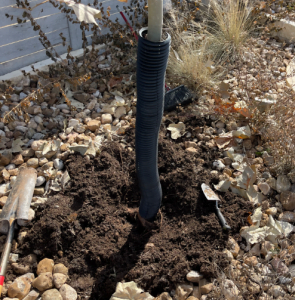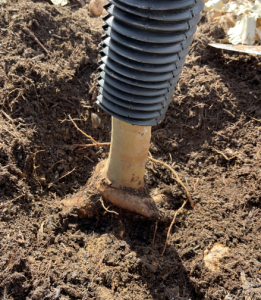Common Tree Problems – Buried Flares and Girdling Roots
Written by Justin Krobot, Operations ManagerOur team at Tree Mann Solutions wishes our clients, colleagues, and friends a Happy New Year! In this coming year, we want to identify common issues and recommendations to help empower our partners to be stewards of healthy trees across Texas.
We wanted to share two problems that our team encounters on a regular basis that are more common in planted trees but are also found in native landscapes.
 Buried Flares
Buried Flares
A buried flare typically happens when planting depth is too low or fill is placed over the existing root flare (also called the root collar) during construction and the tree is buried. Another common occurrence is improper “volcano” mulching where mulch is not spread out properly and is piled up against the trunk. Burying the flare limits the tree’s ability to exchange critical gases and nutrients and triggers the tree to produce adventitious roots to grow closer to the soil surface in new media placed on top of the root ball. As these roots grow and mature, it’s common that they grow out from and across the trunk and can form girdling roots. To avoid a buried flare, our recommendation is to plant trees higher than grade to account for settling and mulch trees property. If you encounter a buried flare on an existing tree, reach out to a Certified Arborist to assess. They may perform a root collar excavation with either a shovel or an air knife that uses compressed air to blast away media from the root ball while not damaging the tree.
 Girdling Roots
Girdling Roots
A girdling root is a root that makes direct contact with the trunk and can grow large enough to constrict the vascular flow of nutrients and water through the tree to the point of injuring and potentially causing dieback within the tree. This can be caused by a buried flare, a root-bound tree, or can occur less-commonly in a native landscape. Our recommendation if you encounter a girdling root would be to call a Certified Arborist to assess and, if necessary, perform a removal procedure with an appropriate care plan to aid in the tree’s recovery. The arborist will weigh options and recommend the best course of action to take to minimize short-term damage to the tree while maximizing long-term tree health.
Please reach out to our team if you have any questions! We appreciate our clients, colleagues, and friends and want to be a resource for healthy trees across Texas!
 Buried Flares
Buried Flares Girdling Roots
Girdling Roots